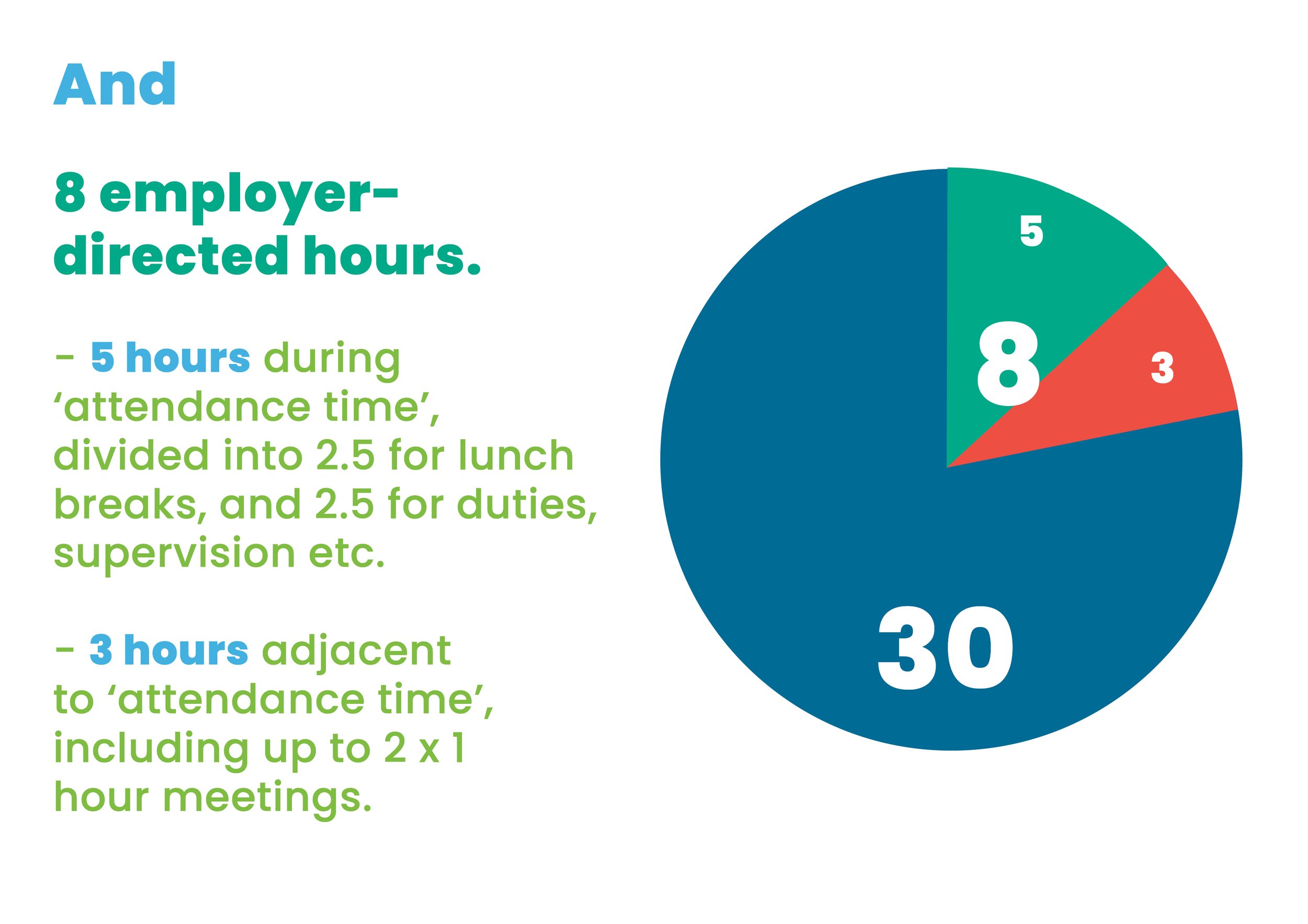Teacher workload wins
The Agreement contains significant improvements to address teacher workload. We’ve put together this explainer video which covers the most significant elements about workload in the Agreement - see below for further information.
The Agreement contains significant measures to address teacher workload, including:
Scheduled Class Time reductions of 1 hour in 2023 and a further half-hour in 2024 - the biggest reductions to SCT in decades.
Limits to before- and after-school meetings of two hours per week (no more than one hour per day).
Annual extras allocation reduced to 10 hours this year, 5 hours in 2024, then eliminated in 2025
Regulation of teacher working hours through the ‘30 plus 8 model’, providing teachers with more control over their time.
Time in lieu for any employer-directed work outside the 38 hour week
Stronger consultative provisions, and better-trained, better-empowered Consultative Committees
Commitments to better manage workloads, deal more efficiently administrative burdens and limit spread-of-hours for part-time staff
Here’s a quick look at five key areas of improvement:
1. Reduced face-to-face teaching limits
This Agreement brings in historic reductions to face-to-face teaching limits – reduced by 60 minutes per week in 2023 and a further 30 minutes in 2024. The Agreement also reduces extras for secondary teachers, removing them altogether from 2025.
For full-time primary teachers, this means that face-to-face teaching limits reduce from 22.5 hours per week to 21.5 this year, then 21 in 2024.
For full-time secondary teachers, limits reduce from 20 hours per week to 19 this year, then 18.5 in 2024.
2. The ‘30 + 8 Model’
This Agreement introduces a completely new approach to regulating the ‘working week’ of teachers - we call this the ‘30 + 8 Model’.
This model brings clearer regulation of the working day. Normal ‘attendance time’ for a full-time teacher will be 7 hours per day, commencing no less than 10 minutes before students start. So, for example, in a school where students are expected in class at 8:50am, a teacher’s normal attendance time could be set at 8:30am – 3:30pm.
There will be 3 additional employer-directed hours which can take place directly before or after normal attendance time (no more than 1 hour on any given day).
Next, the model divides the 38-hour week up into:
30 hours for:
Scheduled face-to-face teaching
Associated work at the teachers’ discretion, free from mandated tasks, duties or meetings.
8 hours, consisting of:
2.5 hours of lunch breaks
2.5 hours for employer-directed tasks, including yard duty, requirements to be in a room before class, lunchtime eating supervision, and directed meetings during normal attendance time
Maximum of 3 hours of directed duties outside of attendance time. This includes a maximum of 2 x 1-hour meetings unless otherwise agreed at the Consultative Committee
3. Time in lieu (TIL)
Along with a more regulated working week comes the introduction of ‘time in lieu’ (TIL) for teachers. Teachers accrue TIL for any required attendance at activities (including camps, parent-teacher interviews, excursions and sport) which occur outside of the 38 hour week.
For every hour of attendance (or for every 2 hours when ‘off-duty’ such as overnight on camps), a teacher is entitled to an hour off work.
If the employer and the employee agree, it can instead be granted as additional payment at the teacher’s normal hourly rate.
4. Workload Commitments
The IEU recognises that administrative burden is one of the biggest contributors to staff workloads. We know that these include increased requirements to collect and interpret data and evidence to inform teaching practice (such as through the NCCD), more complex and labour-intensive assessment and reporting requirements, compliance requirements and training and ongoing curriculum change.
Employers have committed to working in consultation with the IEU to manage employee workload through the following enforceable commitments:
Strategically planning school based and employer based calendars to support the workload of teachers and principals during peak periods.
Fostering collaboration at schools and between schools to enable the sharing of resources and teaching materials.
Developing best practice guidelines for schools on the management of NCCD Data collection and input.
Using purposeful communication to ensure efficient use of emails, meetings and other communication tools.
Promoting clear boundary setting for teachers and principals through consistent communication and email policies
Reviewing and considering the best ways to manage time spent on non-teaching tasks to ensure that teachers can focus on teaching and learning.
Developing guidelines to support teachers and principals manage their time effectively.
These commitments enshrine workload administrative matters within the Agreement and enable the Consultative Committee to deal with a much broader range of matters affecting your workload.
5. Better Consultation
Effective workplace consultation is essential in managing workload at a local school level. This Agreement gives the Consultative Committee stronger powers to deal with workload:
Where a principal makes a decision which is inconsistent with a proposal or recommendation put forward by at least three members of the consultative committee, reasons for the decision will be provided in writing to all staff.
There will be paid training leave for staff reps on the Consultative Committee
These changes will ensure that the Consultative Committee is empowered to make meaningful decisions regarding the workloads of all members of staff.


